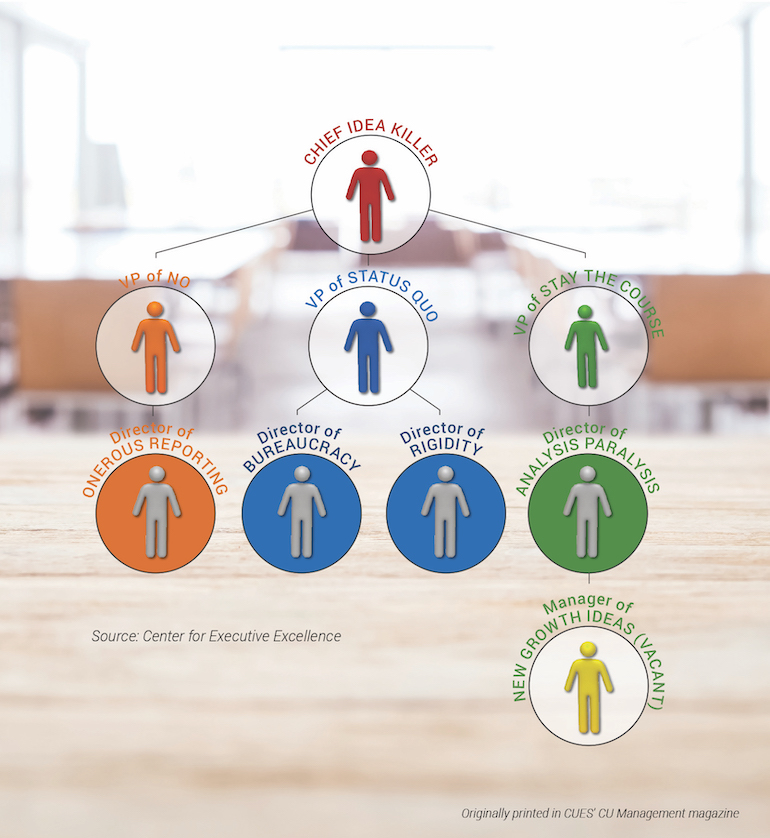3 minutes
Support your CEO’s efforts to create an organizational culture that can transform at the speed of change.
Picture this. Fifty years ago, there were so few international phone lines that some companies with global offices hired squads of “dialers.” Their only job was to dial the telephone all day in hopes of getting an open line.
By 1992, technology began to collapse the boundaries of time and space. That’s when global internet traffic reached 100 GB per day. Within five years, that number increased to 100 GB per hour. By 2002, the rate of traffic reached 100 GB per second. Last year, that rate exploded to 20,235 GB per second, and according to a recent study by Cisco, could reach 61,386 GB per second by 2020.
Information is the new raw material. Performance now depends on turning information into knowledge—and knowledge into service—as quickly as possible.
Unfortunately, most credit unions are underprepared to handle the information tsunami—not necessarily because they lack the technology and business acumen, but because they are stuck in an information-clogging, pyramid mindset.

Today’s CUs are trying to tackle 21st century challenges with structures that have been in place since the rise of city-states in ancient Mesopotamia. For centuries, the pyramid model kept monarchies stable, dictated the rank-and-file system of the military, and enabled factories to manufacture highly reproducible goods from assembly lines. It’s a model that worked well in a world that was relatively stable and predictable.
But today’s business world is anything but stable. A hierarchical organization has virtually no ability to respond and adapt to the rapid flow of information. Today’s leaders must remove the layers, get rid of the bottlenecks and stop rewarding the “information is power” mindset. Those who can do so will create cultures that can transform at the speed of change.
This is not to suggest that your CEO should be pressured into a wholesale restructure. Transforming a culture is not about flattening the org chart or experimenting with the holacracy model like Zappos. Every organization is different. What separates successful 21st century organizations is not the organizational structure itself—it’s the leadership psyche embedded inside the structure.
Reasons to Change
Here are three reasons the pyramid paradigm may be keeping your CU from moving forward:
1. Acquiring and protecting power. People naturally want to learn, grow and be their best both personally and professionally. Under the pyramid model, people must climb their way to the top, squeezing out others along the way. Holding onto their positions requires leaders to continuously fight to acquire and protect their power.
2. Limiting our circle of influence. A leader who is keen on acquiring and protecting power tends to surround himself or herself with a team of direct reports who do not pose a threat to that power. When our circle of influence is made up of people who want to keep their positions by pandering to our ego, our ability to assess reality correctly is severely limited.
3. Operating in a paradigm of scarcity. As we work our way to the top of the organizational pyramid, fewer and fewer positions are available. The pyramid shapes our paradigm of scarcity. Scarcity begets fear. We fear that someone will take our position. We fear never having enough time. We fear that if someone else wins, we lose. This creates stress, tension and a drive for success as a destination that we continually struggle to reach.
How quickly is your CU turning information into knowledge? Are you sharing and responding to information freely, or are people trying to protect their power positions? It’s time to ditch the pyramid and move your CU into the 21st century.
Sheri Nasim is the founder and CEO of Center for Executive Excellence, a leadership consultancy in San Diego. Reach her at 760.521.6382 or snasim@executiveexcellence.com.




